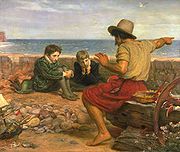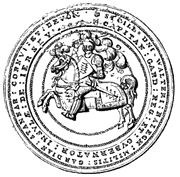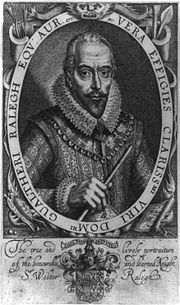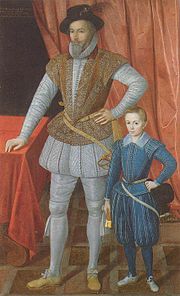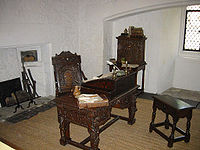
Walter Raleigh
Background to the schools Wikipedia
This selection is made for schools by a children's charity read more. Do you want to know about sponsoring? See www.sponsorachild.org.uk
| Sir Walter Raleigh | |
|---|---|
 |
|
| Occupation | Writer, poet, soldier, courtier, explorer |
Sir Walter Raleigh, Lord Lieutenant of Cornwall (c. 1552 – 29 October 1618), was a famed English aristocrat, writer, poet, soldier, courtier, and explorer.
Raleigh was born to a Protestant family in Devon, the son of Walter Raleigh and Catherine Champernowne. Little is known for certain of his early life, though he spent some time in Ireland, in Killua Castle, Clonmellon, County Westmeath, taking part in the suppression of rebellions and participating in two infamous massacres at Rathlin Island and Smerwick, later becoming a landlord of lands confiscated from the Irish. He rose rapidly in Queen Elizabeth I's favour, being knighted in 1585, and was involved in the early English colonisation of the New World in Virginia under a royal patent. In 1591 he secretly married Elizabeth Throckmorton, one of the Queen's ladies-in-waiting, without requesting the Queen's permission, for which he and his wife were sent to the Tower of London. After his release, they retired to his estate at Sherborne, Dorset.
In 1594 Raleigh heard of a "City of Gold" in South America and sailed to find it, publishing an exaggerated account of his experiences in a book that contributed to the legend of El Dorado. After Queen Elizabeth died in 1603, Raleigh was again imprisoned in the Tower, this time for allegedly being involved in the Main Plot against King James I, who was not favourably disposed toward him. In 1616, however, he was released in order to conduct a second expedition in search of El Dorado. This was unsuccessful and the Spanish outpost at San Thomé was ransacked by men under his command. After his return to England he was arrested and, after a show trial held mainly to appease the Spanish after Raleigh's attack of San Thomé, he was beheaded at Whitehall.
Early life
Little is known about Raleigh's birth. Some historians believe Raleigh was born in 1552, while others guess as late as 1554. He grew up in the house of Hayes Barton, a farmer, in the village of East Budleigh, not far from Budleigh Salterton in Devon, England. He was the youngest of five sons born to Catherine Champernowne in two successive marriages. His half brothers, John Gilbert, Humphrey Gilbert, Adrian Gilbert, and full brother Carew Raleigh were also prominent during the reigns of Elizabeth I and James I. Catherine Champernowne was a niece of Kat Ashley, Elizabeth's governess, who introduced the young men at court. (Ronald, p. 249).
Raleigh's family was strongly Protestant in religious orientation and experienced a number of near-escapes during the reign of the Catholic Queen Mary I of England. In the most notable of these, Raleigh's father had to hide in a tower to avoid execution. As a result, during his childhood, Raleigh developed a hatred of Catholicism and proved himself quick to express it after the Protestant Queen Elizabeth I of England came to the throne in 1558.
In 1568 or 1572, Raleigh was registered as an undergraduate at Oriel College, Oxford, but does not seem to have taken up residence, and, in 1575, he was registered at the Middle Temple. His life between these two dates is uncertain, but, from a reference in his History of the World, he seems to have served with the French Huguenots at the Battle of Jarnac, 13 March 1569. At his trial in 1603, he stated that he had never studied law.
Ireland
Between 1579 and 1583, Raleigh took part in the suppression of the Desmond Rebellions. He was present at the siege of Smerwick, where he oversaw the slaughter of Italian and Spanish soldiers after they had surrendered. Upon the seizure and distribution of land following the attainders arising from the rebellion, Raleigh received 40,000 acres (160 km²), including the coastal walled towns of Youghal and Lismore. This made him one of the principal landowners in Munster, but he enjoyed limited success in inducing English tenants to settle on his estates.
During his seventeen years as an Irish landlord, frequently domiciling at Killulagh Castle, Clonmellon, county Westmeath, Raleigh made the town of Youghal his occasional home, where he was mayor from 1588 to 1589. He is credited with having planted the first potatoes in Ireland, but it is far more likely that the plant arrived in Ireland through trade with the Spanish. His town mansion, Myrtle Grove, is assumed to be the setting for the story that his servant doused him with a bucket of water after seeing clouds of smoke coming from Raleigh's pipe, in the belief he had been set alight. But this story is also told of other places related to Raleigh: the Virginia Ash inn in Henstridge near Sherborne, Sherborne Castle, and South Wraxall Manor in Wiltshire, home of Raleigh's friend, Sir Walter Long.
Amongst Raleigh's acquaintances in Munster was another Englishman who had been granted land there, the poet Edmund Spenser. In the 1590s, he and Raleigh travelled together from Ireland to the court at London, where Spenser presented part of his allegorical poem, the Faerie Queene, to Elizabeth I.
Raleigh's management of his Irish estates ran into difficulties, which contributed to a decline in his fortunes. In 1602, he sold the lands to Richard Boyle, 1st Earl of Cork. Boyle subsequently prospered under kings James I and Charles I, such that following Raleigh's death, Raleigh family members approached Boyle for compensation on the basis that Raleigh had struck an improvident bargain.
The New World
Raleigh's plan in 1584 for colonization in the " Colony and Dominion of Virginia" (which included the present-day states of North Carolina and Virginia) in North America ended in failure at Roanoke Island, but paved the way for subsequent colonies. His voyages were funded primarily by himself and his friends, never providing the steady stream of revenue necessary to start and maintain a colony in America. (Subsequent colonization attempts in the early 17th century were made under the joint-stock Virginia Company which was able to pull together the capital necessary to create successful colonies.)
In 1587, Raleigh attempted a second expedition again establishing a settlement on Roanoke Island. This time, a much more diversified group of settlers was sent, including some entire families, under the governance of John White. After a short while in America, White was recalled to England in order to find more supplies for the colony. He was unable to return the following year as planned, however, because the Queen had ordered that all vessels remain at port in case they were needed to fight the Spanish Armada. The threat of the Armada was only partially responsible for the 4 year delay of the second expedition. After England's victory over the Spanish fleet in 1588 the ships were given permission to sail. Unfortunately for the colonists at Roanoke the small fleet made an excursion towards Cuba in an attempt to capture as prizes the treasure-laden Spanish merchant ships that were reported to be proliferate in those waters at that time. White is said to have objected to this unplanned foray, but was helpless to dissuade the crews who'd been told of the enormous riches to be had by the experienced (he had previously piloted in the Americas in the service of the Spanish), Portuguese pilot hired by Raleigh to navigate the voyage. It was not until 1591 that the supply vessel arrived at the colony, 4 years later, only to find that all colonists had disappeared. The only clue to their fate was the word "CROATOAN" and letters "CRO" carved into separate tree trunks, suggesting the possibility that they were either massacred, absorbed or taken away by Croatans or perhaps another native tribe. Other speculation includes their being swept away or lost at sea during the stormy weather of 1588 (credited with aiding in the defeat of the Spanish Armada). However, it is worth noting that a hurricane prevented John White and the crew of the supply vessel from actually visiting Croatoan to investigate the disappearance, and no further attempts at contact were recorded for some years. Whatever the fate of the settlers, the settlement is now remembered as the "Lost Colony of Roanoke Island".
Later life
In December 1581, Raleigh came back to England from Ireland to despatches as his company had been disbanded. He took part in Court life and became a favourite of Queen Elizabeth I. The various colourful stories told about him at this period are unlikely to be literally true.
In 1585 he was knighted and was appointed warden of the stannaries, that is of the mines of Cornwall and Devon, Lord Lieutenant of Cornwall, and vice-admiral of the two counties. Both in 1585 and 1586 he sat in parliament as member for Devonshire.
Raleigh commissioned the shipbuilder R. Chapman, of Deptford to build a ship for him. Originally called Ark, it became Ark Raleigh following the convention at the time where the ship bore the name of its owner. The crown, in the form of Queen Elizabeth I, purchased the ship from Raleigh in January 1587, for the sum of £5,000 (although this took the form of a reduction in the sum Sir Walter owed the queen: he received Exchequer tallies, but no money). As a result the ship was renamed Ark Royal.
In 1592, Raleigh was given many rewards by the Queen, including Durham House in the Strand and the estate of Sherborne, Dorset. He was appointed Captain of the Yeomen of the Guard, and as Lord Warden of the Stannaries of Devon and Cornwall. However, he had not been given any of the great offices of state. In the Armada year of 1588 he was employed as Vice Admiral of Devon, looking after the coastal defenses and military levies.
In 1591, Raleigh was secretly married to Elizabeth "Bess" Throckmorton (or Throgmorton). She was one of the Queen's ladies-in-waiting, eleven years his junior, and was pregnant at the time of their marriage. She gave birth to a son, believed to be named Damerei, who was given to a wet nurse at Durham House; the infant does not seem to have survived, and Bess resumed her duties. The following year, the unauthorized marriage was discovered and the Queen ordered Raleigh imprisoned and Bess dismissed from court. He was released from prison to divide the spoils from the captured Spanish ship Madre de Dios ("Mother of God").
It would be several years before Raleigh returned to favour. The couple remained devoted to each other. During Raleigh's absences, Bess proved a capable manager of the family's fortunes and reputation. They had two more sons, Walter (known as Wat) and Carew.
He was elected a burgess of Mitchell, Cornwall, in the parliament of 1593.
Raleigh retired to his estate at Sherborne where he built a new house, completed in 1594, known then as Sherborne Lodge but is now extended and known as Sherborne (new) Castle. He made friends with the local gentry, such as Sir Ralph Horsey of Clifton Maybank and Charles Thynne of Longleat. During this period at a dinner party at Horsey's, there was a heated discussion about religion which later gave rise to charges of atheism against Raleigh. He was elected to Parliament, speaking on religious and naval matters.
In 1594, he came into possession of a Spanish account of a great golden city at the headwaters of the Caroní River, and a year later he explored what is now eastern Venezuela in search of Manoa, the legendary city in question. Once back in England, he published The Discovery of Guiana an account of his voyage which made exaggerated claims as to what had been discovered. The book can be seen as a contribution to the El Dorado legend. Although Venezuela has gold deposits, there is no evidence Raleigh found any mines. He is sometimes said to have discovered Angel Falls, but these claims are considered "far-fetched".
In 1596 Raleigh took part in the capture of Cádiz, where he was wounded. He was also the second-in-command of the Islands Voyage to the Azores in 1597.
In 1597, he was chosen member of parliament for Dorset, and, in 1601, for Cornwall. He was unique in the Elizabethan period in sitting for three counties.
From 1600 to 1603, Raleigh was the Governor of the Channel Island of Jersey, and he was responsible for modernizing the defences of the island. He named the new fortress protecting the approaches to Saint Helier Fort Isabella Bellissima, or Elizabeth Castle.
Though royal favour with Queen Elizabeth I had been restored by this time, it did not last. Elizabeth died in 1603, and Raleigh was arrested at Exeter Inn, Ashburton, Devon and imprisoned in the Tower of London on 19 July. Later that year, on 17 November, Raleigh was tried in the converted Great Hall of Winchester Castle for treason due to his supposed involvement in the Main Plot against King James. Raleigh conducted his defence with great skill, which may, in part, explain why King James spared his life, despite the guilty verdict. He was left to languish in the Tower of London until 1616. While imprisoned, he wrote many treatises and the first volume of The Historie of the World, about the ancient history of Greece and Rome. His son Carew was conceived and born while Raleigh was legally "dead" and imprisoned in the Tower of London (1604).
In 1616, Sir Walter was released from the Tower of London in order to conduct a second expedition to Venezuela in search of El Dorado. In the course of the expedition, Raleigh's men, under the command of Lawrence Keymis, attacked the Spanish outpost of Santo Thomé de Guayana (San Thomé) on the Orinoco. During the initial attack on the settlement, Raleigh's son Walter was struck by a bullet and killed. On Raleigh's return to England, the outraged Diego Sarmiento de Acuña, the Spanish ambassador, demanded that King James reinstate Raleigh's death sentence. The ambassador's demand was granted.
Execution and aftermath
Raleigh was beheaded at Whitehall on 29 October 1618. "Let us dispatch", he asked his executioner. "At this hour my ague comes upon me. I would not have my enemies think I quaked from fear." After he was allowed to see the axe that would behead him, he mused: "This is a sharp Medicine, but it is a Physician for all diseases and miseries". According to many biographers — Raleigh Trevelyan in his book Sir Walter Raleigh (2003) for instance — Sir Walter's final words (as he lay ready for the axe to fall) were: "Strike, man, strike!"
The corpse was to be buried in the local church in Beddington, Surrey, the home of Lady Raleigh. "The Lords", she wrote, "have given me his dead body, though they have denied me his life. God hold me in my wits". After Raleigh's execution, his head was embalmed and presented to his wife. She died 29 years later and it was returned to Raleigh's tomb at St. Margaret's, Westminster Raleigh's body was finally laid to rest in St. Margaret's Church, where his tomb may still be visited today.
Although his popularity had waned considerably since his Elizabethan heyday, his execution was seen by many, both at the time and since, as unnecessary and unjust. It has been suggested that any involvement in the Main Plot appears to have been limited to a meeting with Lord Cobham. One of the judges at his trial later said: "the justice of England has never been so degraded and injured as by the condemnation of the honorable Sir Walter Raleigh."
Poetry
Raleigh is generally considered one of the foremost poets of the Elizabethan era. His poetry is generally written in the relatively straightforward, unornamented mode known as the plain style. C. S. Lewis considered Raleigh one of the era's "silver poets", a group of writers who resisted the Italian Renaissance influence of dense classical reference and elaborate poetic devices. In poems such as " What is Our Life" and " The Lie" Raleigh expresses a contemptus mundi (contempt of the world) attitude more characteristic of the Middle Ages than of the dawning era of humanistic optimism. However, his lesser-known long poem " The Ocean to Cynthia" combines this vein with the more elaborate conceits associated with his contemporaries Spenser and Donne, while achieving a power and originality that justifies Lewis' assessment, and contradicts it by expressing a melancholy sense of history reminiscent of The Tempest and all the more effective for being the product of personal experience. Raleigh is also Marlovian in terms of the terse line, e.g. "She sleeps thy death that erst thy danger sighed". A minor poem of Raleigh's captures the atmosphere of the court at the time of Queen Elizabeth I, when he wrote a reply to Marlowe's " The Passionate Shepherd to His Love". Raleigh's response was " The Nymph's Reply to the Shepherd". "The Passionate Shepherd to His Love" was written in 1592, while Raleigh's "The Nymph's Reply to The Shepherd" was written four years later in 1596. Both written in the traditional pastoral poetry, and they follow the same structure of six four-line stanzas employing a rhyme scheme of aabb.
